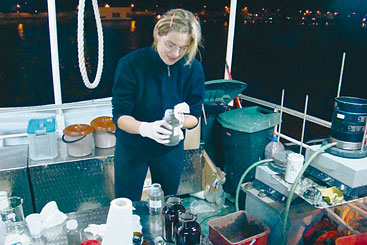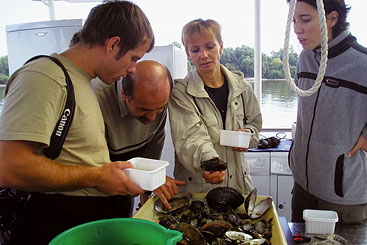The Joint Danube Survey 2 – nobody said it would be easy
ICPDR Danube Watch: Searching for heavy metals behind the Iron Gates

The Joint Danube Survey 2 – nobody said it would be easy
Despite initial setbacks, the largest Danube research expedition finished two days ahead of schedule to bring information on water quality and pollution in the Danube River Basin.

Days before the ‘JDS2’ boat expedition was even launched, heavy rains forced hungary’s Széchenyi ship (complete with cargo, beds and kitchen) to stop 70 km downstream from the launch city of Regensburg, Germany. “The scientists were supposed to first board the Széchenyi in Regensburg and find their equipment, but the rain prevented that”, said JDS2 Team leader béla csányi. “afterwards, many just didn’t know where their equipment was.”
Soon after, the fast opposing Danube current made for a late arrival for Serbia’s Argus research ship at the first sampling station, forcing it to tie up at a private dock in the dark, and its scientific team to take taxis back to Regensburg. It was only at 5:30 the next morning that they could drive back to the Argus and start sampling. And that was only Day 1 with 43 days and 123 sampling stations left!
Once the ships reached Krems, Austria, however, the situation improved. “Now we know where everything is and our work gets better every day”, said Csány i. The crew caught up on sleep, sampling times improved (usually three stations a day) and the Austrians brought survival supplies – muesli, yogurt and chocolate.
New species, new technologies. Th e ‘Joint Danube Survey 2’, also known as ‘JDS2’, was the world’s biggest river research expedition in 2007. Coordinated by the Secretariat of the ICPDR, its main goal is to produce highly comparable and reliable information on water quality and pollution for the entire Danube River and main tributaries. Costing over one million euros, financial contributions came from Danube countries, the EC and private companies.
The international scientific team travelling the entire Danube included 18 scientists. Teams of national sci entists were also a big help on river stretches within their countries. The plan for the three JDS2 boats – the Argus, Széchenyi and Piscius (donated by the EU’s Joint Research Centre to analyse fish) – was to travel 2 375 km down the Danube River, through ten countries, to the Danube Delta. Water, sediment, biology, suspended solids, mussels and fish would be sampled, with some testing taking place on board the ships.

Work on board the Argus often lasted into the wee hours of the night – processing samples to be sent for analyses to onland laboratories, carrying out on-board analyses and preparing and labelling hundreds of bottles, flasks and other vessels.
Over the next few weeks, the scientific teams made many fascinating scientific discoveries. “The expe dition is rich in new data”, said Csányi. “We’re finding animals never found before.” In Germany, the brief mass emergence of the mayfly was observed. “Bridges and ships were covered by millions of these insects which were attracted by artificial lighting”, said Austrian biologist Patrick Leitner. Having disappeared for decades in the 20th century due to water pollution, the mayfly‘s r eturn was a good sign. And around Vienna, sampling revealed invasive species such as gobi, a fish from the Black Sea. “The population of the gobi pest in the German and Austrian Danube has been exploding over the last 15 years”, said Fish Team Leader Christian Wiesner. /p>
Finds in Slovakia and Hungary included the red-list endangered water fern Ricciocarpos and the ‘meateating’ Utricularia – a critically endangered plant in Hungary, and never officially detected before in Slovakia. Near Ilok in Croatia, the floating aquatic fern Azolla was identified for the first time in the Danube. In Serbia, finds included the smallest flowering plant in the world and green algae (Spirogyra) in its reproducin g stage – rarely observed in nature. And in Romania, the very rare Theodoxus transversalis snail was seen, as was “an unidentifiable Crustacean, completely white, with small eyes”.
“The amount of additional information that will result from the JDS2 is quite incredible”, said ICPDR Executive Secretary Philip Weller. “Besides chemical, biological and physical data, we will also have a database of over 10,000 photographs of the river’s structures. New techniques and technologies were also tested for the first time – many of which could make the work of scientists across the globe more accurat e and faster.”
For example, the ‘air-lift’ sediment sampler, the Argus’s most prominent feature, was a big succes s. Used for the first time for Danube sampling, it could take samples at depths up to 11 meters. Before the JDS2, Romanian biologist Gabriel Chiriac had relied on the older methods of ‘kick-and-sweep’ and dredging. “But we couldn’t get to such big depths before”, he said. And ‘core sediment sampling’, a tricky an d expensive business, was done at three sites. In the Iron Gate reservoir, a 70 cm core sediment sample was taken from a 33 m river depth – the deepest sample ever in this part of the Danube. Once removed, the cores are sliced into five cm portions and analysed for a range of pollutants.
Other technical initiatives included the installation of new Donau River Information Services (DoRIS) systems on JDS2 ships, a study of ‘endocrine disrupters’ (organic compounds that impact the hormones of animals) and the testing of a ‘benthic fluorometer’ – a hand-held, ‘in-the-field’ device which may replace the need for doing some chemical analyses in laboratories in the future.

out to see more images from the su rvey. An international team of 18 scientists travelled the length of the river, and national scientists were on hand to help on river stretches within their countries.
Never a dull moment. It would be misle ading to say that challenges ended in the first week of the expedition. “The JDS2 is the most difficult survey on the Danube that I was involved in so far”, says Romanian chemist Carmen Hamchevici, who participated in three earlier surveys. For the ‘Chemical Trio’ – including Carmen, Romania’s Mary Craciun and th e Czech Republic’s Hana Hudcova – work in the Argus lab usually lasted until midnight – processing samples to be sent for analyses to on-land laboratories, carrying out on-board analyses and preparing and labelling hundreds of bottles, flasks and other vessels.
One particularly noteworthy day was August 29, the ‘day of disasters’, when the equipment lifting the airlift sediment sampler and the power supply on board the Argus stopped. This stopped the pumps from delivering regular water samples and disabled the crane from lifting a smaller sampling boat in and out of th e water. On other days it was the breakdown of the centrifuge needed for microbiological analyse s, the sieves used for sampling sediments or the Piscius ‘electro-fisher’ for identifying fish species. Then there were the heavy winds, cold, rain, waves and late hours (especially for the Fish Team’s ‘night sampling’). In Bulgaria, fierce waves hurled a small sampling boat against the concrete banks. In Slovakia’s Gabcikovo reservoir, the waves made by a very unfriendly nearby boat almost overturned the Piscius, its crew and equipment.
Making the news. The JDS2 stopped at t en cities where local and national authorities had planned events and, in most cases, press conferences. These typically included JDS2 team members, the ICPDR and local and national authorities including high-level officials such as Austrian Minister for Environment Josef Pröll, followed by demonstrations on board the ships. “The news reached the biggest newspapers and radio and TV stations in each country, so that more people than ever now know about the importance of the Danube and what their governments are doing to improve the situation”, s aid Lucia Ana Varga, ICPDR President 2007 and Romanian State Secretary in the Ministry of Environment and Sustainable Development.
Raising public awareness about the Danube was one of the JDS2 main goals from the start. Public events a nd media efforts were complemented by the ICPDR’s coordination of a ‘Watch your Danube’ campaign, which included a website posting daily ship diary entries and results, fact sheets, posters and leaflets – all for trans lation and distribution by Danube governments.
On September 25, the ships reached the Black Sea – a first for many of the Széchenyi’s sailors who celebrated with ‘baptisms’ of poured saltwater. On the 26th, the team sampled the last site at St Gheorghe, Romania , two days ahead of schedule! “There was an indescribable enthusiastic feeling among the entire scientific team and crew”, said Csányi. They had successfully sampled all 96 sites on the Danube River and 28 on its tributaries. It was over.
On the 27th, the official end of the survey was held in Tulcea, Romania, headed by Romania’s Lucia Ana Varga, including a final ceremony, traditional folk music and dancing. “We are all tired, but we are happy,” sa id Czech biologist Jarmilla Makovinska. “And a little bit sad. We all became a very close group.”
“It’s hard to believe we’re finally in Tulcea, looking back at all the difficulties we had to go through”, said JDS2 Technical Coordinator Jaroslav Slobodnik, the human link between all of the tasks that needed to be done between ship and land. “It’s almost a miracle that we did it.”
By the summer of 2008, the results from all analyses will be reviewed, and findings will be reported to the Danube country governments. “The ministries will then be in a much better position to decide on what measures they will need to do to address the pollution and other problems of the Danube River Basin”, said Weller. “The final conclusive results will then be reported to the public and media.”
(Read the JDS2 background story in the June 2007 Danube Watch; and see the website at www.icpdr.org/jds f or scientific results, maps, photos, fact sheets and short stories.)





